Insecurity in Burkina Faso – beyond conflict minerals: The complex links between artisanal gold mining and violence
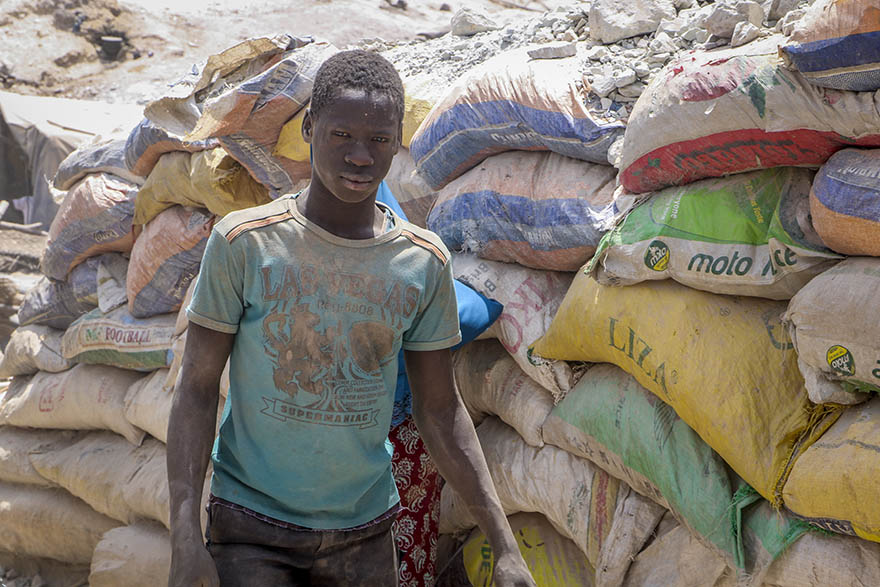
A dust-covered miner at a gold mine, Burkina Faso, 23 February 2020. Photo: Sam Mednick, AP
As artisanal gold mining in Burkina Faso has increased in recent years, so have violent attacks by non-state armed groups. The assumption that there is a natural causal link between the two is, however, too simplistic. The escalating violence should rather be seen as a result of long-term trends, such as state disengagement, a growing dependence on gold and the gradual privatisation of security. To curb the violence, we recommend that policy makers avoid a repressive approach to artisanal mining and rethink the governance of the sector, in consultation with miners and rural communities.
Policy note by Cristiano Lanzano, senior researcher at NAI, Sabine Luning, associate professor at Leiden University and Alizèta Ouédraogo, national coordinator at the Artisanal Gold Council (AGC) of Burkina Faso.
What’s new?
Burkina Faso’s economy has shifted from dependence on agriculture to dependence on gold production. Concurrently, the growing insecurity across the Sahel has brought increased challenges from non-state armed groups. Government has to cope with the proliferation of violent attacks, coupled with an upsurge in the number of civilian self-defence groups in rural areas. Media narratives associate the increase in violence with the increase in gold mining, fuelling concerns about ‘conflict minerals’, the idea that resource extraction will inevitably stimulate an escalation of violence. However, the simplicity of this narrative needs to be challenged in light of complex national politics.
Why is it important?
Since 2015, armed violence has caused at least 1,000 deaths, and mass internal displacement. Attacks have targeted the workers and infrastructure of industrial gold-mining companies, but insecurity has also affected artisanal and small-scale gold mining (ASGM), albeit in more complex ways. Armed groups stand accused of trying to control mining activities. Speculation about jihadist recruitment and financial links between ASGM and these groups has been rife, but evidence is limited. Effective solutions to end violence cannot develop without a better understanding of the relationship between gold mining, armed groups and the state.
What should be done and by whom?
Narratives about ‘conflict minerals’ must be nuanced. For years, private concessionaires have controlled the governance of ASGM, contributing to the privatisation of security. Unsurprisingly, the emergence of jihadism and self-defence groups has exacerbated this tendency. To reverse this trajectory, government policies must address the needs and demands of miners and rural communities for security, helping to restore trust in the state.
On the night of 4–5 June 2021, insurgents killed at least 160 civilians in an attack on the gold-mining community of Solhan, a village in north-eastern Burkina Faso. This area is part of the tristate region, with Mali and Niger, which for the past five years has been the focus of a surge in violence perpetrated by various armed groups claiming an affiliation to Al Qaeda, Islamic State and other terrorist networks. The attackers, riding some 20 motorcycles, targeted first the local civilian defence force, Volontaires pour la défense de la patrie (VDP), and then an artisanal gold mine, before going on to burn down homes and a market. Just weeks before, the minister of defence had visited the region to declare that increased military efforts had rendered the area and population safe. After the attack, the regional governor banned artisanal gold mining, arguing that terrorist groups were encroaching on gold-mining regions. This attack, the deadliest so far for civilians, raises the question of how gold mining is implicated within the current insecurity. It highlights fragilities in state protection and the need to assess the effects of involving civil vigilante groups.
Since the late 1990s, the gold-mining sector has expanded in Burkina Faso, nurturing hopes of increased tax revenues and benefits from resource-led development. In previous decades, the state took centre stage as the organiser of artisanal and small-scale gold mining (ASGM); however, from the mid-1990s the prospect of a booming gold sector drove major reforms to liberalise mining and to attract foreign investors to develop largescale gold mining (LSGM).
The neoliberal shift under the regime of Blaise Compaoré (1987–2014) resulted in LSGM and ASGM becoming a focus for patrimonial networks that crossed state–private boundaries. This revealed a paradox: businessmen involved in gold buying were well connected to the elite around Compaoré, i.e. the elite that controlled the state, but their illegal activities caused ASGM to become a locus for weakening the state. The shadows created by this nexus of state–private relations around gold and amplified by neoliberal policies are currently haunting Burkina Faso.
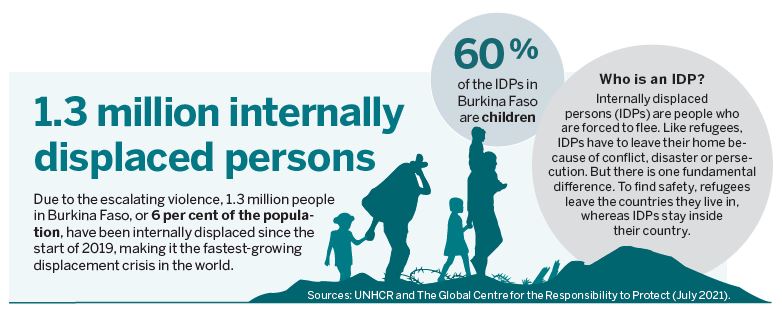
Contours of a fragile state
After Compaoré’s fall in 2014, political transition was characterised by a struggle between the elite pro-Compaoré Regiment of Presidential Security (RSP) and the regular military. This culminated in a failed coup in September 2015. In November 2015, the presidential elections brought to power Roch Marc Kaboré, a politician who, despite a longstanding career within Compaoré’s regime, had turned against him. Despite the voters’ yearning for a rupture with the past, the result of the elections also signalled their desire for a return to an experienced government that could navigate away from political instability.
In January 2016, a few days after the inauguration of Kaboré’s government, deadly terrorist attacks were mounted in the capital city, Ouagadougou. Many pointed to former president Compaoré – who had allegedly struck deals with jihadist groups to safeguard Burkina Faso’s territory – and to the fact that his removal had opened the floodgates and exposed the country to armed groups. During the first five-year term of Kaboré, who was re-elected in November 2020, Burkina Faso became a magnet for violence and terrorist attacks, leading to clashes within communities and the internal displacement of almost a million citizens.
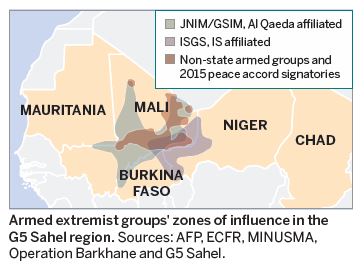
In late 2019, the attacks seemed to subside. This may have been a consequence of strengthened military capacity, successful pushbacks against violent groups, the formalisation of civilian defence groups, or international
relief projects and programmes to improve inter-communal relations. However, from the end of April 2021, violence in the east and the north of the country has again surged alarmingly, as the attack in Solhan tragically demonstrated.
Portraying Compaoré’s manoeuvring as the sole cause of the violence needs some nuancing. The internal struggles within the military and the 2015 coup attempt gave Kaboré’s regime reason to distrust the army, and this led to a reshuffle of military staff and the redistribution/dismantling of military equipment. This reduced the capacity of the military to defend the national territory. Moreover, in rural areas, the presence of the state was already weakening, even before Compaoré’s departure. Indeed, for many discontented urban and rural youth, the new government led by Kaboré perpetuated old problems, rather than embodying hope for a better future. Land conflicts, resource-related disputes and political disillusionment prepared the ground for violent groups to capitalise on discontent.
Self-defence groups and communal violence
Alongside its coverage of so-called jihadist armed attacks and the mounting insecurity, the Burkinabe press has reported on the increasing popularity of vigilante and self-defence groups, such as the Koglweogo (meaning ‘guardians of the bush’ in Mooré). After 2015, many new branches were formed, especially in smaller towns and the rural areas of central and northern Burkina Faso. They started to pursue criminals and to mete out extra-judicial punishment. After 2018, they de facto became involved in combating violent extremism – raising with greater urgency the question of the erosion of the state monopoly on violence.
Locally, Koglweogo groups enjoy legitimacy and are able to mobilise political connections. However, they also play a role in the escalation of local conflicts built on longer histories of pressure on land and mobility. In western Burkina Faso – a Mande-speaking area with a longer history of hosting Mossi farmers and gold miners – rivalry emerged between Koglweogo groups and the Dozo traditional hunters. Dozo hunters play a similar role of self-defence, but within more established donsoya (hunting) institutions.
In the central and northern regions (historically Mossi), the presence of Fulani (Peul) semi-nomadic herders has become stronger, as a consequence of Sahelian drought and processes of sedentarisation. In recent violence, the Fulani have been attacked by self-defence groups, which have accused them of collaborating with jihadists. Koglweogo groups are also suspected of being associated with gold buyers or criminal networks. Therefore, it is important to analyse the current violence in a broader perspective, considering the histories of migration and the relations between communities, the patterns of economic inequality and state vulnerability.
The government’s position on self-defence groups is contradictory, oscillating between condemnation and attempts to formalise them. In January 2020, a parliamentary bill formalised the recruitment and training of armed ‘volunteers for the defence of the homeland’, i.e. the already mentioned VDP. This spurred debate on the spiralling violence and the danger to which volunteers would be exposed. International observers have also pointed to abuses by the Burkinabe military, and at cases of extra-judicial killings as part of counter-terrorism operations. The blurring of a monopoly on violence and those who represent ‘the law’, as well as issues of accountability, may fuel mistrust and resentment among the populations affected.
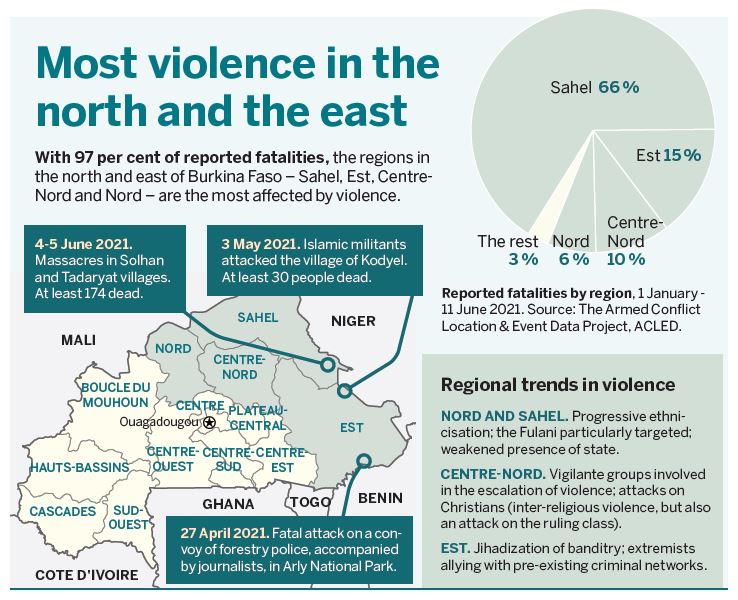
The hybrid governance of artisanal mining
In ASGM, the chain of production and commercialisation of gold is structured around hybrid patterns of governance that mix formal legislation with semi-legal practices and informal arrangements. The artisanal mining sector is regulated by the national mining code (last amended in 2015), and miners and traders can gain formal recognition through licences and permits. However, several stages of production remain at least partially informal. Extraction is performed by teams of miners, who secure access to the resource through informal negotiations with – and tribute payments to – landowners or chiefs. Ore processing is performed by operators who similarly secure permission to work on a mining site, and then agree their compensation informally with the miners.
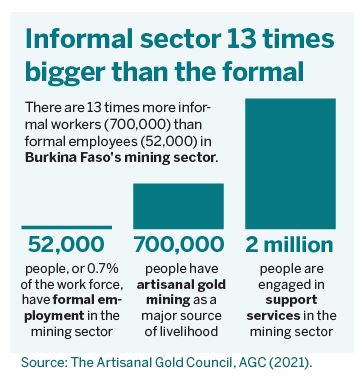
Up until 2006, the parastatal Office of Precious Metals (CBMP – Comptoir Burkinabè des Métaux Précieux) functioned as a regulatory body and as the ultimate (and sole authorised) gold buyer. With economic liberalisation under Compaoré, gold buying was privatised, and several civil servants who had previously worked for the CBMP became licensed private gold buyers. In the first decade of the twenty-first century, these local private companies – usually referred to as comptoirs – also assumed an informal role of central governance and territorial control at many mining sites.
Private comptoirs tried to monopolise the commercialisation of gold through capillary networks of individual gold buyers, who secured their relations with miners by offering them loans and support. Comptoirs also deployed private security forces to discourage smuggling, which nonetheless remained widespread. After 2010, increased competition, a decline in production and resistance from miners challenged the dominance of the private comptoirs in ASGM.
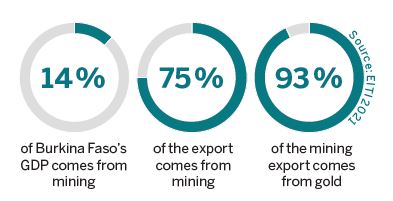
Their decline was accelerated by the end of Compaoré’s rule in 2014 and by the emphasis of the new transitional government on investigating abuses and reforming the mining sector. Nowadays, while they still buy gold, most comptoirs have lost their territorial presence and have been replaced by local committees, generally composed of miners’ representatives, local residents and customary authorities.
Funding of terrorist and criminal networks?
Artisanal mining sites may have been implicated in various ways in the activities of jihadist groups, criminal networks and self-defence groups. On occasion, mining sites have been violently targeted in an attempt to chase miners away from an area. In October 2019, for example, an armed group killed around 20 gold miners at a site near Arbinda, in the north west.
Suspicions that ASGM has become an opportunity for laundering money and financing violence have also been aired in the local press. A 2021 report from the Burkinabe Economic and Social Committee estimates that between 2016 and 2020, some 70 billion West African francs (CFA) – 105 million euro – went on funding terrorist activities. According to the daily newspaper Sidwaya, the report argues that, alongside the proceeds of robbery, poaching and drug trafficking, gold has contributed to the funding of violent groups.
Jihadist groups consider gold extraction to be halal (lawful), and this legitimises pressures for payments from miners. These payments may be framed as protection money, in line with longer traditions governing relations between Touareg and sedentary groups in the region of Dori. In the provinces of Séno and Soum, groups of gold miners have paid jihadist groups to guard sites. In eastern Burkina Faso, groups affiliated to Islamic State in the Greater Sahara (ISGS) and the Support Group for Islam and Muslims (GSIM) try to enforce sharia law and levy zakat, a system of obligatory alms of 10 per cent of one’s income.
These practices are not always viewed by the local population as oppressive. Protection may even be solicited by miners, sometimes in response to actions by the state or other actors. Counter-terrorism operations that target mining equipment may, in some cases, have driven local miners closer to the jihadists. Decisions to close artisanal mining sites in the east have had an adverse effect, depriving miners of their income sources and triggering requests for support from jihadists. The recent ban on gold mining in the northern provinces, imposed by the regional government in reaction to the deadly attack in Solhan, has also sparked criticism. Conceived as a means of depriving the terrorists of one of their funding sources, it might backfire, nurturing frustration and economic dependence in a region where the state is largely absent.
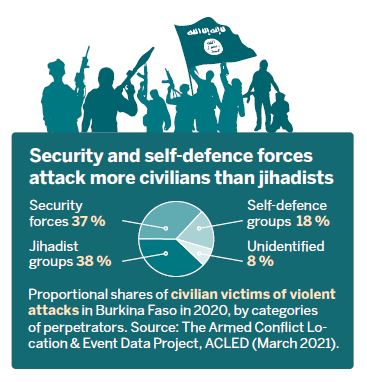
Current alliances can build on pre-existing tensions and conflicts, for example in those cases where – as reported by the International Crisis Group – private comptoirs have tried to retain control of the gold trade with the support of self defence groups, leading gold miners to react by seeking protection from jihadist groups. Although the investigations into the attack at Solhan are still ongoing, similar dynamics may have been at work there.
Restoring state control of artisanal mining
In 2015, a new government agency to support and formalise ASGM was created – Agence Nationale d’Encadrement des Exploitations Minières Artisanales et Semimécanisées (ANEEMAS). Its mandate is to reorganise the marketing of the gold produced at ASGM sites and to prevent smuggling, but also to offer technical support to miners, minimise the environmental impact and combat child labour. ANEEMAS is commonly supposed to have assumed the functions of the old CBMP. However, the decade-long dominance of the private comptoirs and the creation of many informal local committees have fragmented commerce in artisanal gold to a degree inconceivable prior to 2006. Since gold is targeted by different networks implicated in the current violence, the immediate resumption of national control over gold marketing would appear to be unrealistic. Instead, ANEEMAS has opted for a gradual approach, beginning by identifying ‘pilot sites’ for it to establish its presence.
While this approach may allow for the negotiated presence of state representatives in mining areas, it is also problematic. The campaigns, training sessions and facilities built at individual sites evoke the logic of time-limited development projects, rather than root-and-branch reform of the sector. And the fact that ANEEMAS receives funding from international donors may reinforce this perception. More generally, reports suggest that most miners do not feel sufficiently involved in the mandate of ANEEMAS and instead perceive the agency as an additional competitor, or as a curb on their freedom to establish agreements with their providers and customers. The effectiveness of ANEEMAS will depend on the role that it carves out in relation to other state agencies and security forces, and also on the legitimacy that it succeeds in gaining in the extremely fragmented landscape of artisanal mining.
Conclusions
There is no automatic or ‘natural’ link between violence, insecurity and artisanal gold mining. Violence in ASGM areas (by either extremist or vigilante groups) has to be understood in relation to the long-term trajectories of state disengagement from the artisanal mining sector, and to the gradual privatisation of security in areas (formerly) controlled by private companies. State initiatives to formalise ASGM may provide an important step toward restoring security, but only if they are part of wider strategies of engagement, in close collaboration with miners and other operators active in the sector.
Policy recommendations
- Involve miners and related operators in the implementation of mining formalisation schemes to avoid formalisation initiatives being perceived as competition.
- Acknowledge the power dynamics at work in ASGM, in order to tackle inequalities and to protect the rights of the most vulnerable workers.
- Recognise that rural poverty, pressure on land and the ethnicisation of tensions expose people to recruitment by extremist groups. Hence, an exclusively repressive approach that bans ASGM is unlikely to succeed and may prove counter-productive.
- Defuse violence by tackling structural factors of rural poverty and inequality and by balancing territorial disparities.
- Address the needs and demands of miners and rural communities for security, helping to restore trust in the state.
- Continue to critically scrutinise how the state is implicated in the violence through military action and by backing civil armed groups.
